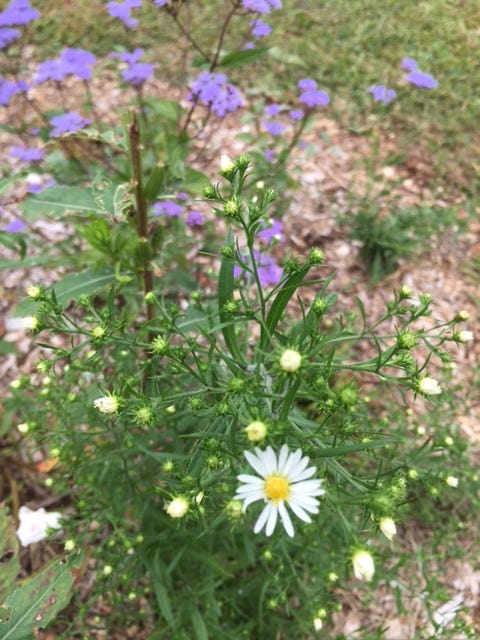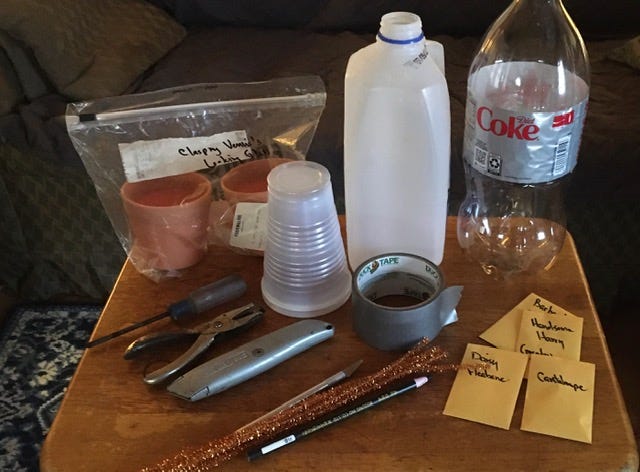Cooler Weather Shouldn’t Stop Anyone From Gardening!
Here's another repost of an article from my "Through the Lens of a Nature Lover" archive. Hope it motivates you to get outside and get your hands dirty!
Cooler temps have arrived, and many of my flowers are starting to look a bit ragged. The few holdouts, though, are being rewarded for their patience by all the winged visitors stopping by for a quick snack. Bumblebees, other native bees, wasps, flies, and tiny little bugs I can’t identify are building up their frequent flyer miles, buzzing around and checking out the assorted take-out cuisine.
None of them seem to mind me or my dog hanging about. Tiger is fascinated by the activity and insists on poking his nose in their business. Luckily, the bugs ignore him. They’re too busy concentrating on fattening themselves up for the winter and gathering as much pollen as possible to feed their larvae over the colder months.
Meanwhile, I have my work to do as well. Autumn is the best time to work outside in the garden. Just because the weather is getting cooler doesn’t mean it’s time to put up the trowel and vegetate inside the house. Goodness, no!
Planting and Transplanting
Now is the time to plant flower bulbs. There will be less competition from other plants and weeds, and it will give the plants time to start adjusting to their new home before the ground freezes. Bulb plants will not work in containers if you’re planning on starting next year’s garden with the winter sowing method of germinating seeds. (More about that below.) So, take advantage of the cooler days and get all those bulbs in the ground.
Autumn is also the perfect time to divide up the perennials that are getting too crowded. The lower temperatures and moister soil help the plants deal with the stress of being dug up, cut apart, and replanted. It’s also an economical (free) way to increase the size of your garden, and your plants will appreciate the extra breathing room. You can find information on the types of perennials that can be divided and how to do it on the web.
If you want to move plants, autumn is the time to do it. However, wait until they’re dormant and finished producing seeds. Then, dig up a generous portion of soil along with the plant making sure to include as many roots as possible. Break up the soil in the bottom of their new homes so the transplants can easily settle in to their new abode.
Trees and shrubs will also benefit from being planted while they’re dormant. It’s tough for these guys to survive in containers during the colder months. Their roots can quickly freeze without the protection of the insulating soil. Another advantage of autumn planting is that even though the visible parts of the newly planted saplings may not be active, their roots are getting established underground, granting them a head start for the coming spring.
Hint: For a little added boost, place some leaves inside the hole with the bulbs and transplants. The organic matter will break down and supply nutrients to the growing plants. While you’re at it, put some leaves around them on top of the soil too.
Winter Sowing
I’ve mentioned Winter Sowing in several of my past articles. For those of you not familiar with this method, here’s a quick explanation.
After the holidays, life can become very boring for gardeners. The numerous excuses for running outside to putter around the garden no longer apply. There are no more weeds to pull or veggies to water. The cold weather, bare sticks, and terrible television shows are beginning to drive you stir-crazy. If only there were a way to play in the dirt without your family disowning you.
There is! Winter sowing. All you need are some plastic containers, tape, a box cutter, a grease pencil, potting soil, and seeds.
Winter sowing was introduced by Trudi Davidoff over twenty years ago and is defined by the USDA as a “propagation method used throughout the winter where temperate climate seeds are sown into protective, vented containers and placed outdoors to foster a naturally timed, high percentage germination of climate tolerant seedlings.”
In other words, seeds are planted in moist potting soil inside vented plastic containers and left outside during the winter. The containers act as mini-greenhouses to start the seeds on their way to germinating and growing. By being left outside, the seeds that need cold stratification are subjected to the low temperatures necessary to break seed dormancy naturally instead of depending on the fridge to do it.
You can use plastic milk/water bottles, soda bottles, or other transparent covered containers, flower pots covered with shower caps, or zip-close bags. I will not go into lengthy detail on preparing the containers since that information can be found online. However, I will attest to the simplicity, efficiency, and success of my own attempts at winter sowing.
Both flowers and vegetables can be winter sown, but the timing for different types of seeds varies. For example, cold-tolerant perennials and annuals can be started in late December or early January, while various vegetables need to wait until April. The beauty of this system is that you can work on it at your own pace. If you only want to fill five containers at a time or fifty, it’s up to you. Best of all, it keeps you occupied during the winter through early spring.
Winter sowing won’t give you a head start on spring planting. This type of sowing does not make seeds germinate sooner. Instead, they’ll continue doing their thing as Mother Nature intended, but the seedlings will be heartier, less prone to stress, and will transplant more easily.
Here’s a link to a fantastic winter sowing Facebook group. They have a “Featured” tab with many articles and posts on how to winter sow, which seeds will work, and when to plant them. It’s a wonderful place to learn all about winter sowing. Plus, the folks are very friendly, patient, and will answer all your questions.
There you have it. Now’s the time to start saving half-gallon and gallon jugs and other plastic containers. (The containers need to be large enough to hold at least four inches of potting soil.) Winter sowing won’t begin until after Christmas, so you still have plenty of time to gather supplies.
With this cold weather activity, there’s no longer any need to watch mind-numbing reruns. Gardening can now be a year-round pastime. Enjoy!
~~~~~~~~~~~~~~~~~~~~~~~~~~~~~~~~~~~~~~~~~~~~~~~~~
Dear Reader,
I'd be ever so grateful if you would take a few minutes to recommend Let's Get Our Hands Dirty to your followers on Substack and other social media platforms.
Thank you!
Greta
---------------------------
Let's Get Our Hands Dirty is a reader-supported publication. This post is free as are all my posts. Please subscribe so you can receive notification when new articles are published. I'd love for you to become a part of our nature-loving family. Basic subscriptions are free, but if you sign up for a paid subscription as a love offering, that would be wonderful and greatly appreciated!
Have a fabulous day,
Greta
Please use the buttons below to Like, Comment, Restack, and Share my post on Substack and other social media platforms.
THANK YOU SO MUCH!







